ROCKETSCIENCE |
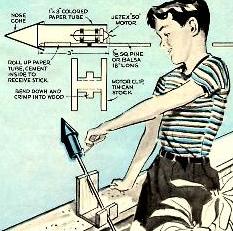 |
ROCKETSCIENCE |
 |
There is a public perception that the science related to rocketry is very difficult - hence the negative expression "it's not rocket science" said about something that is not difficult.
The truth is that the physical and mathematical foundations of rockets are not difficult, which we will attempt to show. What is difficult is not rocket science, but rocket engineering. The basic principles underlying rocket science were laid down by Isaac Newton. However, applying those principles to escape the Earth's gravity requires high pressures, temperatures and velocities, and finding materials and building structures to withstand these parameters is the really difficult part.
THE FOUNDATION LAW
The British scientist Isaac Newton stated three fundamental laws of mechanics that are very important in a number of disciplines, including rocketry. These laws are:
The resolution of this discrepancy is of course that on the Earth, the ball is contantly exposed to the external force of gravity (and to a lesser extent air resistance) and these forces determine its subsequent motion.
However, in space, well away from the influence of any massive body (such as a planet or a star) an object will continue to move at a constant velocity.
The third law (N3) is the basis of rocket motion. If we throw something out the back of a rocket, the rocket will move forward. You can demostrate this by holding a brick while standing at rest on a skate board on a horizontal surface. On throwing the brick in one direction, you will move off in the opposite direction. You will eventually come to rest again, but this is because of frictional forces acting on the board (and yourself).
It is the second law (N2) however that allows us to compute how much stuff we have to throw out the back of a rocket and how fast it needs to be thrown, for of the three laws N2 is a quantitative law that permits mathematical calculations.
Many high school students learn that Newton's second law may be written as the formula F = m a, where F is the external force on the body, m is its mass and a is its acceleration. However, if we applied this formula to rocketry where the external force is zero (at least in deep space), we would have to conclude that the acceleration of the rocket was zero - that is, a rocket could never work. However, this is obviously not so.
The resolution is that although in many practical situations (those in whch the mass of the body is constant) F=ma is quite adequate, Newton did not state N2 in this form. The reason that in rocketry, F=ma is totally inadequate, is due to the fact that the mass of the rocket is continually changing, as gases are shot out the back. The most general form of N2 may be written:
where p = m v is the momentum of the body
and dp/dt is the time rate of change of this momentum.
(m is the mass and v is the velocity of the body)
 |
Isaac Newton (1643 - 1727) formulated the laws of physics relating to the motion of objects, and set the stage for quantitative rocket science. These laws were set forth in his book "Principia Mathematica Philisophiae Naturalis" published in 1687. |  |
BRIEF HISTORY OF ROCKET SCIENCE
The history of the use of rockets may trace back into antiquity, and is certainly established in China in the 13th century. However, these uses are rocket engineering, on an experimental basis without an underlying basis of the relevant science. True rocket science is generally traced to the Russian high school mathematics teacher Tsiolkovsky who in 1903 published a work with a title translated as "The Exploration of Cosmic Space by Means of Reaction Devices". This work was virtually unknown outside Russia for many decades.
In America Robert Goddard started directed experimentation with rockets and published his ideas in a 1919 work entitled "A Method of Reaching Extreme Altitudes".
In Germany in 1923 Hermann Oberth published a version of his doctoral thesis "The Rocket into Planetary Space" after the thesis was rejected by the University of Munich.
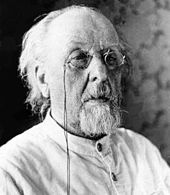 Konstantin Tsiolkovsky (1857-1935) |
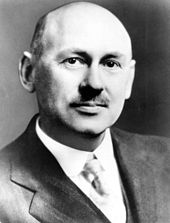 Robert Goddard (1882-1943) |
THE ROCKET EQUATION
When a rocket is used for propulsion in outer space, there are no external forces acting on it (we will consider the case of planetary operation later). Thus, in N2, we may write F=0. This then gives us the formula:
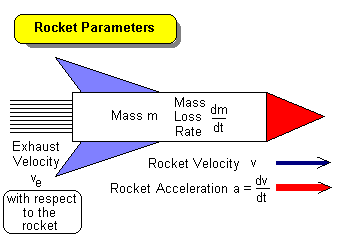
Typical values of exhaust velocity are given for various chemical propellants in the table below.
| Propellants | ve m/s | |
|---|---|---|
| Solid Fuel in Model Rocket | 850 | |
| Solid Fuel - Large Boosters | 2300 | |
| Oxygen - Kerosene | 2500 | |
| Nitrogen Tetroxide - Hydrazine | 2900 | |
| Oxygen - Ammonia | 2900 | |
| Oxygen - Hydrogen | 3600 | |
| Fluorine - Hydrogen | 4000 |
To find the velocity of the rocket at any instant we must integrate the above equation with respect to time:
the solution of which is:
vf - vi = ve [ ln(mi) - ln(mf) ]
If we let Δv = vf - vi then the solution of the above equation gives us an expression for Δv, the increase in forward velocity of the rocket due to the burn:
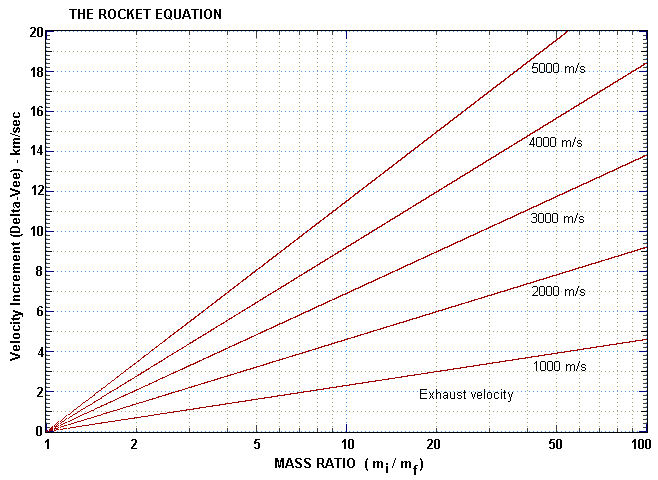
In practice, liquid fuelled rockets have mass ratios below 10 whereas solid fuelled rockets may achieve mass ratios of up to 20.
We can turn R1 around to determine the required mass ratio (mi/mf) for a specified Δv :
A little bit of algebra gives us a third version of the rocket equation as a function of ζ (zeta) :
THE THRUST EQUATION
The rocket equation (R1) tells us that the change of velocity of a rocket due to a fuel 'burn' is only related to the exhaust velocity and the total amount of fuel consumed. It does not say anything about the duration of the burn. It is thus not the whole story, for time is very relevant when we need to consider the thrust of the rocket at any instant. This is something that is extremely important when trying to take off from a planetary surface where gravity is acting.
Consider the example of an ion drive where small sub-atomic particles are accelerated to very high velocity (ve) and thus result in a very efficient rocket engine. Because only a limited number of particles can be accelerated to high velocity every second, the thrust is small, and so although very efficient for travel in zero gravity conditions, an ion engine is useless to try and escape the gravitational pull of a planet.
The thrust equation results very simply from the application of N2 to the rocket:
In a gravitationl field g (this is the acceleration due to gravity and has the units of metre per second squared), the total force acting on the rocket as it lifts off from the surface of the gravitating body (eg a planet) is:
The resultant initial acceleration of the rocket when the engines are first lit is thus:
Of course, as the rocket ascends, its mass decreases, and if the thrust is relatively constant, the acceleration of the rocket will increase.
IMPULSE
The concept of impulse relates to the total effect of the thrust over the time that it acts. If the thrust force FT. which may vary over time, acts from a time interval Δt = t2 - t1, then the total impulse on the rocket over the time from t1 to t2 is given by:
There is another type of impulse that is often used in comparing rocket performance, and that is termed the specific impulse Isp. This is defined as the thrust per unit rate of mass loss:
However, because you will find specific impulse (the engineering kind) mentioned in many books and journals it is good to note that by simply multiplying this quantity by 10 you have the exhaust velocity of the rocket to within 2% - adequate for most purposes.
FLUID DYNAMICS
To investigate rocket science further we need to investigate the quantities in the rocket equation. In this section we will start to look at the quantity ve, the gas exhaust velocity. The basic physics involved concerns the equations of fluid dynamics. The two of these that are relevant to us are the continuity equation and Bernoulli's equation. Both of these are essentially conservation laws. The first expresses the conservation of mass and the second the conservation of energy.
The Continuity Equation
This equation relates to an incompressible fluid (one whose density is constant) and is concerned with mass flow past a point.
Imagine we have fluid flowing along a tube whose diameter changes. If we have a mass passing one point in the tube each second, then that same mass must pass through any point along the tube in the same amount of time. This can only happen by a change in the velocity of the fluid.
Thus:
Bernoulli's Equation
Bernoulli's equation expresses the conservation of energy along a streamline of incompressible fluid in non-turbulent flow:
All the terms in F2 have the units of pressure, which can also be interpreted as energy per unit volume (hence F2 is an expression of energy conservation). The terms Po + ρ g h represent the static pressure of the fluid and ρ v2 / 2 represents the dynamic pressure of the fluid. Another way to express this is that ρ g h is the potential energy density of the fluid while ρ v2 / 2 is the kinetic energy density.
In the absence of a gravitational field, or in zero gravity conditions there is no potential energy contribution (g = 0), and so F2 becomes:
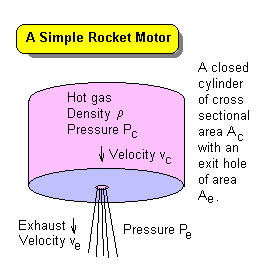 A very simple rocket motor might consist of a cylinder of high pressure gas with a small exit hole in one end of the cylinder as shown in the adjacent diagram. The cross-sectional area of the cylinder is Ac, whereas that of the exit hole is Ae. The density of the gas inside the cylinder is ρ and the pressure is Pc. The velocity at which the gas inside moves toward the exit is vc.
A very simple rocket motor might consist of a cylinder of high pressure gas with a small exit hole in one end of the cylinder as shown in the adjacent diagram. The cross-sectional area of the cylinder is Ac, whereas that of the exit hole is Ae. The density of the gas inside the cylinder is ρ and the pressure is Pc. The velocity at which the gas inside moves toward the exit is vc.
We now consider a point just outside the exit hole. We can assume that the gas has not yet had time to expand so that the density is still the same as inside the cylinder. However, the velocity and pressure have the values ve and Pe respectively.
Bernoulli's equation in this instance becomes:
By applying the continuity equation F1:
However, the above equation would also seem to indicate that the thrust will increase as we increase the size of the exit aperture (ie more mass comes out per second). However, we cannot make the exit hole too large or the conditions under which we derived the equation are then no longer valid. Specifically, the internal gas velocity will not be much less than the external velocity and the large internal pressure will quickly dissipate.
THERMODYNAMICS
Only toy rockets use compressed gas as a propellant. Most rockets use a chemical reaction to generate gases as hot as possible. These are expanded through a special nozzle to ensure optimum operation.
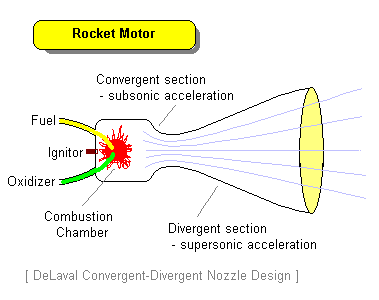
The laws of thermodynamics which relate to the movement of matter and thermal energy can be used to produce an expression for the exhaust velocity:
In a vacuum, the term in the square brackets [ ] is zero and γ and R are constant giving the approximation:
It can be seen from the above approximation that a high temperature and a low molecular weight are desirable to produce the largest exhaust velocity. The best conventional fuels are hydrogen and oxygen which combust to produce water vapour with a molecular weight of 18. In an ion engine where protons are accelerated in the engine, the molecular weight is one. However, these engines can so far not throw anywhere like enough mass out the back to give a useful thrust for planetary escape, and so are confined to low gravity conditions. Conventional rocket engines work at temperatures below 3000 Kelvin, and then only because of complicated cooling arrangements which prevent the combustion chamber and nozzle walls from vapourising.
ROCKETRY ON A PLANET
Two main differences exist between rocket operation in space versus rocket operation on a planet. One is due to the presence of an atmosphere, and the second is due to the presence of a gravitational field.
An atmosphere has two effects on rocket operation. Atmospheric pressure works to decrease the effective exhaust velocity of the rocket. The external pressure Pe in the above equations is effectively zero in space and atmospheric pressure on a planet. The degradation in thrust can thus be calculated when the atmospheric pressure is known.
The second effect of an atmosphere is to produce a drag force on the rocket. This drag force opposes (is in the opposite direction) to the thrust force and increases as the rocket velocity increases. The form of the drag force is given by the expression:
It is difficult to incorporate the drag force into analytical rocket equations because of the dependence on velocity and altitude (through atmospheric density). When it is necessary to compute drag effects it is generally done numerically on a computer where the exact trajectory can be calculated in an iterative process.
Gravity always acts in a vertical direction downwards. If we consider flight only in the vertical direction then by the definition of acceleration (ie time rate of change of velocity) we can write for the case of constant acceleration 'a' over a time interval t:
Using equation K1 we can see that gravity reduces the velocity of a rocket by an amount g t in the vertical direction. Including this term in the rocket equation gives us the modified form of the rocket equation in a gravitational field:
or Δv = ve ln ( mi / mf ) - Δv / α
MULTISTAGING
The final velocity of a rocket vertically launched from the surface of a planet, at the moment of engine cut-off is given by the equation:
If we use equation G2 and assume a constant acceleration, we can plot a graph showing the mass ratio required at different exhaust velocities to achieve a specified velocity.
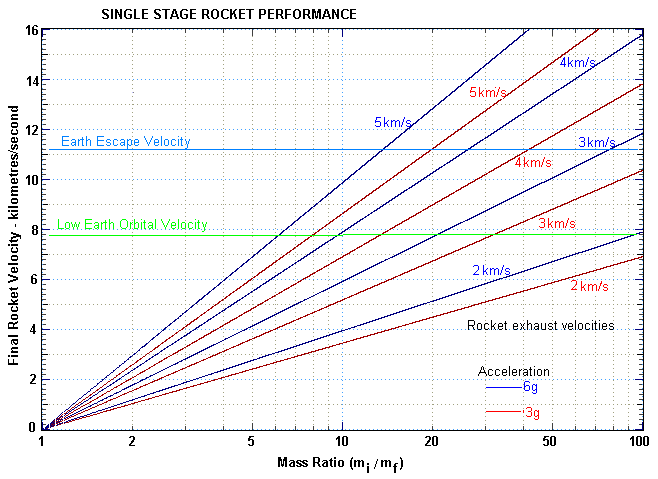
Now a maximum practical mass ratio for a large rocket is about 10. This means that the final mass is 10% of the initial mass, which allocates 90% of the mass to the useable fuel and 10% of the mass to the rocket structure itself plus tanks, engines, control systems and payloads. For an acceleration of 3g (α=3) it requires an exhaust velocity of 4500 m/s to achieve a mass ratio of 10, if the rocket is to achieve orbital velocity. This exhaust velocity is higher than the best chemical propellants (hydrogen - oxygen) can achieve. This is why a single stage to orbit rocket has not yet been developed.
To achieve orbital velocity and higher we must (so far) use multistage rockets.
Consider a 3-stage rocket with an acceleration of 3g and an exhaust velocity of 3500 m/s. If the mass ratio for the first stage is 3 (ie fuel is 67% of the first stage mass plus the mass of the two subsequent stages) then the first stage will achieve a velocity at burnout of 3 km/s. At burnout the first stage drops away leaving the remaining two stages. If the following two stages have a similar mass ratio (after losing the stage mass below them) they will each add a delta-vee of 3 km/s for a total velocity of 9 km/s which is adequate to achieve low Earth orbit. We can write the total velocity achieved vT as the sum of the delta-vee's of each stage:
In the above example we have assumed that the parameters of each stage are identical. This is unlikely to be the case and in practice each stage will have a different mass ratio, a different acceleration and possibly a different exhaust velocity.
REFERENCES
 Australian Space Academy
Australian Space Academy